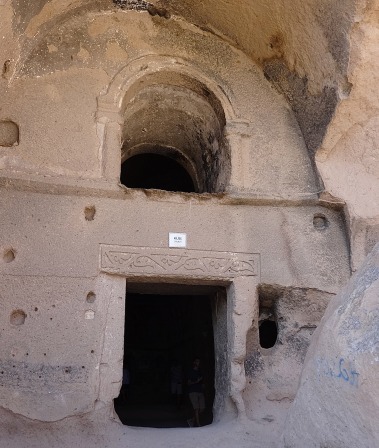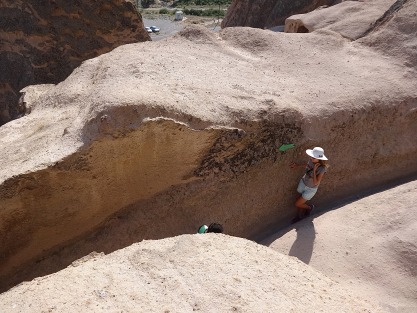“Leaf Castle” (Yaprakhisar) Population: less than 750
At the northern end of the Ihlara Gorge in Cappadocia is the village of Yaprakhisar. It’s well worth continuing a little further north to Selime where, across the road from a small cemetery dominated by a Selçuk-era türbe (tomb), a huge rock formation rises up by the roadside.
As ever with the rock formations it’s hard to provide any firm information about its history. Today it’s labelled as Selime Cathedral but in truth it probably served as a monastery with several rock-cut churches and a chapel as well as dramatic views over the surrounding countryside. It’s possible that some parts of the structure were used as a school in Byzantine times. They may also have been used as a stable for caravans, hence the covered passageway labelled as the Kervan Yolu (Caravan Road).
More obviously, the rock is also believed to have served as a castle at times in its history. It was here that one Ali Paşa is said to have made a stand for the Selçuks against the advancing Mongols in the 13th century although he died for his pains.
As for the claim that Christian services were first held in public here, I would like to hear the evidence.
Exploring the Cone
A mini-ravine of a path winds up and emerges in front of the group of churches and an extraordinary kitchen with a soaring chimney, uncannily reminiscent of the one to be seen amid the ruins of Glastonbury Abbey in England.
The first of the churches and the easiest to reach is accessed via an entrance with an elaborately carved lintel stone. It boasts an upstairs gallery and its floor is pitted with the holes that served as tandır ovens when it was turned into accommodation at a later date.
Accessed via a metal ladder, the structure labelled as the actual cathedral has thick-set columns dividing it into a nave and two aisles. A stone chancel screen survives in front of the apse. This church-cathedral is believed to have been built in the 8th or 9th century.
It is still just about possible to make out 10th to 11th-century frescoes, presumably telling Bible stories, running along the edges of the barrel vault above the nave although unless restoration is carried out soon they will inevitably vanish. Figures of the saints run along the arches while geometric patterns, some of them looking disconcertingly like the symbols for spades in a pack of cards, ring the capitals of the columns.
Facing the cathedral, the chapel is a far simpler “church” in a separate cone. Inside you’ll find a curious carving of two birds, one on either side of a cross.
If you visit on your own you should take time to wander round the base of the huge rock cone. Behind it you’ll find another small soot-blackened chapel behind blind arcading carved into the rock. Here, too, you’ll find Selime itself, a village of old stone houses, almost all of them abandoned.
If you follow the road as it heads out of Selime towards Yaprakhisar you wlll come to some fine fairy-chimney rock formations on the right-hand side of the road before the modern village. These days tour groups bus many people up to the Selime monastery but hardly anyone ventures further to inspect these cones.
Star Wars – Myth and Reality The story that George Lucas’ original Star Wars was filmed in Cappadocia seems to have started in Selime when a visitor peeped out at the landscape and said that it reminded him of the movie. The rest, as they say, is history and many a false claim in adverting leaflets. However, the rock cone DID feature in an infamously bad Turkish version of Star Wars starring Cüneyt Arkın, The Man Who Saves the World.
 Transport info
Transport info
These days many tours to Ihlara start or end at the Selime Monastery.
Dolmuşes from Aksaray stop in Selime en route to Ihlara.


